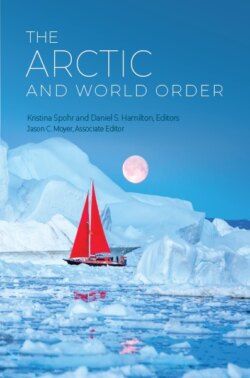Читать книгу The Arctic and World Order - Группа авторов - Страница 7
На сайте Литреса книга снята с продажи.
From Unknown Unknown to Zone of Peace
ОглавлениеA century ago, the High North was still the unknown unknown—an epic adventure playground for explorers such as Fridtjof Nansen and Roald Amundsen, home to Indigenous Inuit hunter-fishermen from Greenland to Alaska, and nomadic reindeer herders in Lapland and Siberia. After 1945, however, these icy backwaters gained strategic importance as a front line in the Cold War.
The initial arming of the region began as the United States and the Soviet Union each developed strategic bombers and then ballistic missiles, capable of delivering nuclear weapons across the North Pole. In the process the empty lands started to be developed. The U.S. and Canadian militaries established a string of high-tech radar stations from Alaska to Newfoundland. Bases in Greenland, Iceland and Norway hosted U.S. and other NATO forces. Air- and sea-launched cruise missiles were deployed and tested in the West’s polar territories. Meanwhile, the USSR conducted over a hundred underground nuclear tests at its so-called North Test Site on the Novaya Zemlya archipelago. Then, from the 1960s, the often-ice-covered Arctic seas became the main operational arena for nuclear-powered attack submarines. Dangerous cat-and-mouse games ensued. This was a “virtual war,”9 one that was as much high-tech as it was high-risk in which the two players regularly “met,” always with the threat of nuclear Armageddon lurking should the game get out of hand. Significantly, by the mid 1980s, 60 percent of the Soviet Union’s submarine-based strategic nuclear forces were based or operated in the vicinity of the Kola Peninsula, very close to Norway and the North Atlantic.10
Despite the greater tension, small-scale forms of cooperation broke new ground. Some even included the Cold War rivals. In 1956, the Nordic Saami Council (Sámiráđđi) was established to promote the rights of Sámi people in Finland, Norway, and Sweden, setting a precedent for formalized Indigenous cross-border collaboration in the North. In 1973, five Arctic Ocean coastal states, Canada, Denmark, Norway, the Soviet Union, and the United States, signed the Agreement on the Conservation of Polar Bears, which was not only among the first multilateral cooperative arrangements during the Cold War, but has since been furthered by several management agreements between the United States and Canadian Indigenous governments, and by the agreement on the conservation and management of the Alaska-Chukotka polar bear population signed by the United States and Russia in 2000.11 In 1975, Norway and the Soviet Union signed the first in a series of bilateral agreements that formed the basis of the Barents Sea fisheries regime.12 In 1977, the Inuit Circumpolar Conference (later Council) was founded to represent the Inuit of Canada, Alaska, Greenland, and—since 1989—of the now former Soviet Union, laying the ground for what would become one of the most innovative features of circumpolar collaboration, the high-level engagement of Indigenous representatives in the Arctic Council.13
As the Cold War faded, Arctic cooperation grew exponentially, spurred in part by Mikhail Gorbachev’s 1987 “Arctic zone of peace” speech in Murmansk. A flurry of collaborative bodies were formed, including the International Arctic Science Committee, the Council of the Baltic Sea States, and the Barents Euro-Arctic Region.14 In 1991 the eight countries with terrain above the Arctic Circle—Canada, Denmark, Finland, Iceland, Norway, Russia, Sweden, and the United States—got together with representatives of Indigenous peoples and signed the Arctic Environmental Protection Strategy. Considering the turbulent history of the region, this agreement on a common Arctic Action Plan was unprecedented. Five years later, this arrangement, originally focused on an environmental agenda, grew into the Arctic Council—a unique forum of state actors and Indigenous peoples to promote co-operative governance in the region while emphatically not engaging with military issues.15
These developments went hand in hand with a wider transnational phenomenon: domestic moves towards political devolution away from capitals in Alaska, Canada and the Nordic countries, and with growing recognition and assertion of Indigenous rights and strengthened representation of native peoples nationally and regionally. Many of those peoples now saw a real chance to be heard, and to invest their energies into mechanisms designed to address specific Arctic issues and to convey a sense of the significance of these concerns to the world at large.
By the time the new millennium dawned, the region that after 1945 had been a testing area for missiles and nuclear weapons had become a proving ground for more cooperative approaches, not only among states but between state and non-state actors as well. The Arctic came to be seen by some as an exemplary “territory of dialogue”16 that reflected a more human and humane approach to international affairs than the antagonistic power politics that had played out there before and during the era of bipolarity.
The emerging architecture of collaboration was marked by a strong focus on Arctic-specific issues. As Oran Young has noted, it gave structure to “the idea of the Arctic as a distinctive region with a policy agenda of its own,”17 one that could be insulated from global political dynamics. Such efforts proved difficult, however, as global environmental changes and processes of globalization began to intrude. Relatively harmonious circumpolar cooperation also developed during this period in part because of the relatively benign political environment of post-Cold War international order. Today, as power has diffused, Great Power competition has returned, and as the mutual interplay between Arctic and global issues has accelerated and become quite palpable, the question now is whether the region can continue its pioneering role, this time with regard to governance arrangements that can effectively manage both competition and cooperation as well as conservation and extraction efforts.
